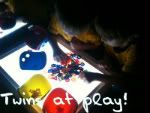Top Ten Things to Be Thankful For When You're a Preschool Teacher.
10. A wonderful assistant who seems to be able to read your mind at times, and who doesn't mind helping clean up a giant mess after an activity that doesn't quite go as planned.
9. Rest time, need I say more?
8. Washable paint, markers, dry-erase crayons, otherwise many pairs of pants would end up in the "work-only" stack.
7. That one creative co-worker who is always there to bounce ideas off of, or put a different spin on something. Along those same lines, that one co-worker who knows what you're going through with that one child and is always there to lend a hand.
6. Parents who "get it"- the ones at the end of the day don't ask their kids, "what did you learn at school today?" instead they say "tell me what awesome things you did today, did you play with so-n-so, go outside, or get messy?" Those parents who thank you at the end of each day and appreciate the fact that managing a room full of preschoolers is sometimes hard.
5. A boss who also "gets it". Early Childhood is not school! Okay, well yes it is, but it's PRE-school for a reason! Skill & drill just isn't appropriate. Having a boss who gets this and supports developmentally appropriate practice makes a world of difference!
4. A spouse or significant other that also "gets it"-- he or she doesn't mind the fact that there is that special corner of the house where you are hoarding tp rolls and boxes and milk jugs. Who gets that "I need to run into the craft store/teacher store/Wal-mart" could turn into a hour and $100. Who listens as you explain how today Johnny finally asked for a turn instead of clobbering the kid and stealing the toy.
3. That reliable substitute assistant or teacher who you trust your classroom with 100%.
2. The fact we are PRE-school and there are no worksheets, homework, and tests. We get to do what comes natural to kids- PLAY- and teach at the same time.
1. Those 10 or 15 or 20 snotty nosed, germ infested, loud, creative, wild children you call your class. While they can push your buttons, and don't seem to remember that we don't pick our nose (no matter how many times you explain it), they are the reason you love your job. They are amazing "sponges" dying to try out whatever new manipulative or activity you bring in. They are the ones who accidentally call you "mom" or "dad" but call their parents by your name. They are the ones who pick up a book and want to read it just like you do at Circle Time. They are the ones who are growing & learning every day making your job worth it.
7. That one creative co-worker who is always there to bounce ideas off of, or put a different spin on something. Along those same lines, that one co-worker who knows what you're going through with that one child and is always there to lend a hand.
6. Parents who "get it"- the ones at the end of the day don't ask their kids, "what did you learn at school today?" instead they say "tell me what awesome things you did today, did you play with so-n-so, go outside, or get messy?" Those parents who thank you at the end of each day and appreciate the fact that managing a room full of preschoolers is sometimes hard.
5. A boss who also "gets it". Early Childhood is not school! Okay, well yes it is, but it's PRE-school for a reason! Skill & drill just isn't appropriate. Having a boss who gets this and supports developmentally appropriate practice makes a world of difference!
4. A spouse or significant other that also "gets it"-- he or she doesn't mind the fact that there is that special corner of the house where you are hoarding tp rolls and boxes and milk jugs. Who gets that "I need to run into the craft store/teacher store/Wal-mart" could turn into a hour and $100. Who listens as you explain how today Johnny finally asked for a turn instead of clobbering the kid and stealing the toy.
3. That reliable substitute assistant or teacher who you trust your classroom with 100%.
2. The fact we are PRE-school and there are no worksheets, homework, and tests. We get to do what comes natural to kids- PLAY- and teach at the same time.
1. Those 10 or 15 or 20 snotty nosed, germ infested, loud, creative, wild children you call your class. While they can push your buttons, and don't seem to remember that we don't pick our nose (no matter how many times you explain it), they are the reason you love your job. They are amazing "sponges" dying to try out whatever new manipulative or activity you bring in. They are the ones who accidentally call you "mom" or "dad" but call their parents by your name. They are the ones who pick up a book and want to read it just like you do at Circle Time. They are the ones who are growing & learning every day making your job worth it.
Until Next Time & Happy Thanksgiving!!,























